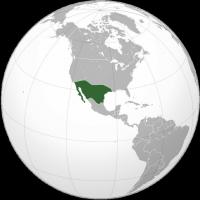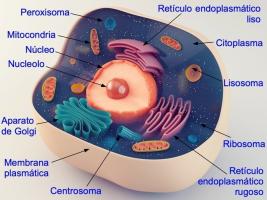The main parts of plants: characteristics and functions
Plants are a large group of living beings, made up of eukaryotic cells that carry out the process of photosynthesis. In this group we find algae, ferns, mosses, trees, herbs and shrubs. They all have particular characteristics, however, we can distinguish these four main organs in most:
- Root: where the plant obtains water and minerals.
- Stem: gives support to the plant.
- Sheet: where they capture light for photosynthesis.
- Flower: responsible for sexual reproduction in plants that is transformed into fruit and seed.
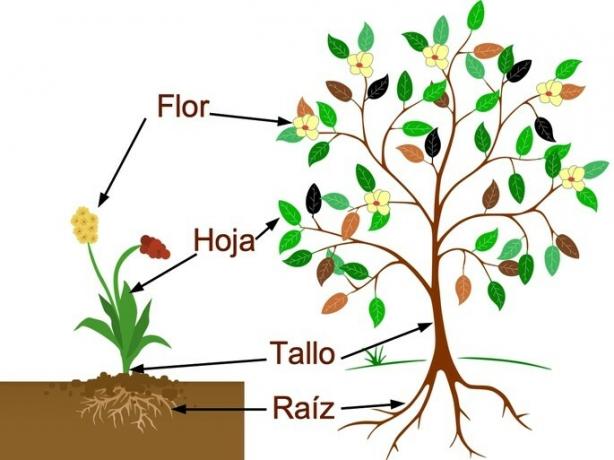
Estate
The roots are the part of the plant that provides fixation and nutrition. Some plants have their roots buried in the ground, which can go from a few centimeters to meters, looking for water and elements for growth and development. Other plants have aerial roots with which they cling to a support, such as orchids.
Some plants lack roots. This is the case of bromeliads, plants that only survive in very humid and rainy environments, so that the water can be absorbed by the leaves.
The roots have the following functions:
- Anchor the plant: the root stabilizes and fixes the plant in a substrate or base, in such a way that they orient the stem, the leaves and the flowers towards the sun and the pollinating agents.
- absorb water and chemicals: the elements that the plant needs for its activities, such as potassium, phosphorus and magnesium, are found in the soil and are absorbed together with the water through the root.
- produce hormones: in the roots the hormones gibberellin and cytokinin are synthesized that regulate the growth and development of the shoots.
- store carbohydrates: Some roots serve as a deposit for sugars, such as carrots, beets and radishes, which are then used by the plant to survive during the winter. Human beings take advantage of these roots to feed us.
root structure
Apical meristem zone: is the tip of the root. Growth occurs in this region, as it has the ability to push through the soil. The tip is protected by the cap, a thick layer of cells that is constantly multiplying and secretes a lubricant that makes it easier for the root tip to pass through the soil.
elongation zone: Above the root tip is a region where cells undergo division and expansion.
hairy area: region where structures in the form of hairs are concentrated. Root hairs increase the absorption area and last a few days, after which they degenerate.
types of roots

There are two types of root systems:
- Main root: is the system where there is a main central root from which other roots branch. The taproot develops from an embryonic root called the radicle, present in the seed. It is present in trees, in bean plants, tomatoes and roses.
- adventitious roots: or fibrous root system, it is found in monocotyledonous plants, such as onions, corn and gladioli. It is characterized by presenting threads of independent roots.
modified roots
Many plants have roots that are out of the ordinary:
- storage roots: In plants that live for two years, the roots are the permanent organs, so the stored carbohydrates are used to produce new shoots in the spring.
- support roots: they are roots that are generated from the stems, as in the case of some palms, corn, Ficus and mangroves.
- aerial roots: Many orchids live on other plants, so their roots have to reach out and grab onto the bark of trees.
- symbiotic roots: some roots establish a symbiotic relationship with soil fungi, forming mycorrhizae. Others, such as the roots of legumes, form nodules with bacteria of the genus rhizobium, capable of capturing nitrogen from the air and transforming it into ammonia, which the plant can then use to produce amino acids.
- Haustorial roots: they are roots of parasitic plants, that is, plants that live at the expense of another plant.
stems
The stem is the organ that supports the leaves, flowers and fruits. It belongs to the shoot system of the plant and connects the rest of its parts with the roots. Most are on the surface, but there are some, like potatoes, that also grow buried in the ground.
The main function of the stems is to raise the leaves so that they can be better exposed to sunlight. The stem also carries material to and from the leaves. In addition, we eat the stems of some plants, for example, potatoes and asparagus.
Among the characteristics of the stems we can mention:
- Size: the stem can measure a few millimeters, like some mosses, up to tens of meters, like sequoias.
- Diameter: it is also variable, they can be as thin as rice stems, or as thick as the tree of Santa María del Tule, in Oaxaca (Mexico) that measures 14 meters in diameter.
- Structure: the stems can be herbaceous, like corn or wheat, or woody, like cork oaks and pines.
- Shape: the stem can be single, like the palm tree, or branched, like the apple tree.
stem parts
In the stem of many plants we can distinguish the nodes, the places where the leaves join, and the internodes, the regions between nodes. The leaves are attached to the stem by the petiole.
If we cut across a stem in angiosperms we can see the epidermis, cortex and vascular tissues. The stem epidermis is a single layer of cells that cover and protect the tissue below. Woody plants have a tough, waterproof outer layer of bark cells that gives added protection.
The xylem and phloem make up the vascular tissue of the stem. The xylem transports water from the bottom up in the plant, the phloem collects the sugars and amino acids produced in the leaves.
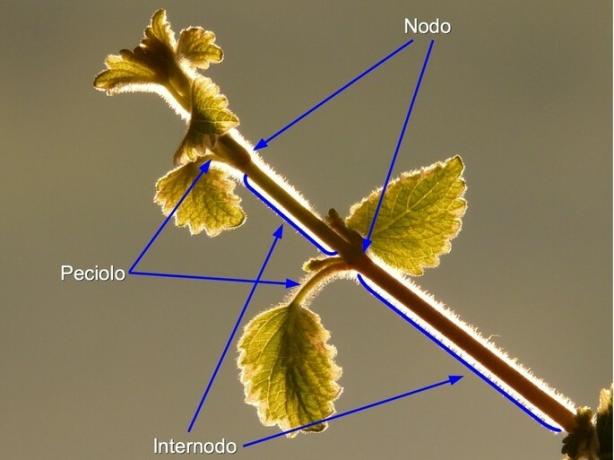
modified stems
- rhizomes: they are horizontal stems that allow the plant to extend below the surface, such as bamboos, ferns, irises and ginger.
- tubers: they are horizontal and grow for a short period of time. Its function is to store nutrients, as in the case of potatoes.
- bulbs: they are short shoots, some have fleshy leaves, like onions and garlic, others have paper-thin leaves, like saffron and gladioli.
- Stolon: they are extensions of the stem, as in strawberries.
You may also be interested in seeing Tuber, tuberous root and bulb.
Leaves
Leaves are the production organs of photosynthesis. During photosynthesis, they absorb carbon dioxide and convert it into carbohydrates using light energy.
In addition to the photosynthetic function, the leaves offer protection to the plants, through the thorns and the scales of the cocoon; support by means of the tendrils; storage as the fleshy leaves of the bulbs and even obtaining nitrogen, in the case of insectivorous plants.
The leaves are a source of food for the vast majority of living things. Humans eat leaves like lettuce, spinach, cabbage, artichokes, and onions. We use basil, bay leaf, oregano, parsley and mint as spices.
Among the characteristics of the leaves we have:
- assorted shapes: lanceolate, like the willow, linear like the wheat, acicular like the pine, elliptical like the rose, reniform, like the cyclamen.
- margins: They can be continuous, serrated, toothed, lacerated or divided.
- Colors: we associate leaves with the color green, but they can also take on other colors, such as yellow, red or purple.
- Texture: there are smooth leaves like the banana leaf, silky like the verbasco, or sticky like the gardener's love (Galium aparine).
- Size: They can be as small as the moss, or huge, like the water lily.
- Sheet: it can be simple, like the leaves of the oak, the mango or the pepper, or compound like the leaves of the rose or the jacaranda.
leaf structure
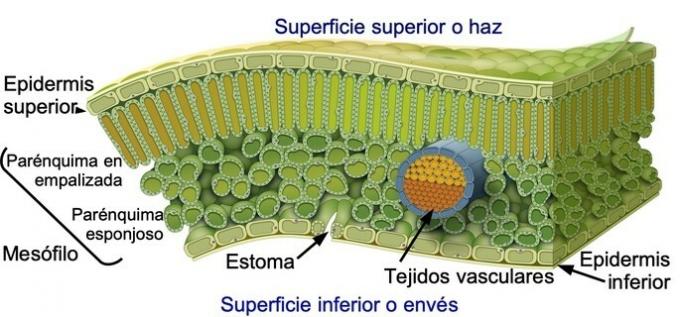
We can distinguish two parts in the leaf: the petiole and the blade. The petiole is the transition between the stem and the leaf blade, which is the extended part that we recognize as "leaf".
The leaf has the following internal structure:
- Epidermis: flat thin layer that serves to capture light and perspiration. In the lower epidermis, stomata prevail, pores that open to the external environment and through which the movement of gases and perspiration occurs.
- mesophyll: comprises the internal tissues between the epidermis. In an upper layer are the palisade parenchyma cells where photosynthesis occurs; below is the spongy parenchyma.
- vascular tissues: they are inside the mesophyll and are in charge of distributing the water that comes from the xylem and the load of sugars inside the phloem.
Types of modified leaves
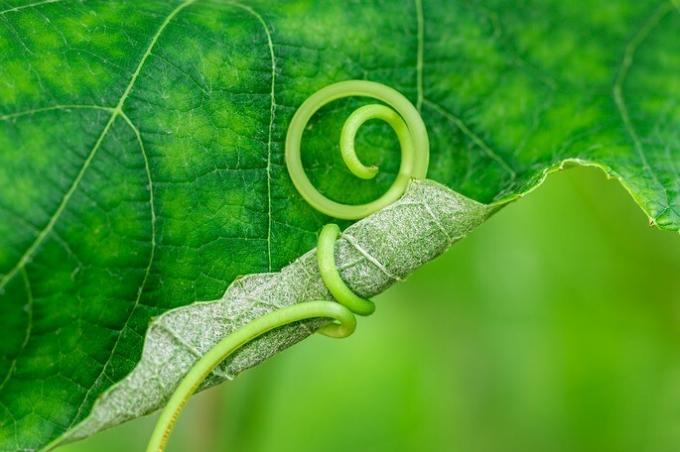
succulent leaves: They are thick and fleshy leaves that favor water conservation. They prevail in desert conditions and are characteristic of the families Chassulaceae (Kalanchoe and sedum), Portulacaceae (Portulaca and lewisia) and Aizoaceae (ice plant).
Sclerophyll foliage leaves: they are resistant, stronger and more durable leaves, like the leaves of the Agaves and Yucca.
coniferous leaves: They can be simple, needle-like, as in pines, firs, and spruces, or small and flat with scales, as in cypresses and junipers. These plants are always green because they do not lose their leaves in the winter.
thorns: they are modified leaves that sprout in auxiliary buds. It is shaped like a needle, which helps protect the plant against herbivores.
scales: at the tip of shoots or buds, these leaves protect the future growth of the plant.
tendrils: are leaves that grow like spirals on climbing plants, such as peas, cucumbers, passion fruit or vines. They have cells capable of detecting contact with objects, which causes them to roll up. In this way they support the plant.
insect traps: they are modified leaves with the capacity to trap and digest insects in habitats poor in nitrates and ammonium.
Flower

Flowers are the sexual reproductive organs of plants. Some plants have flowers with exclusively female or male parts, such as corn. Others keep the male and female parts in a single organ, like the flower of the apple tree.
The function of the flower is to ensure successful pollination. Pollination is the process of transferring pollen grains from the stamen to the stigma, where they germinate and form a tube through the style to the ovary. Sperm cells are transferred from the pollen grain down the tube to the ovary, where they fertilize the egg.
In flowers we can distinguish the following structures:
the sepals: They protect the other parts of the flower as they develop.
The petals: they attract pollinators after the sepals have parted to allow the flower to open.
The stamen or androecium: It is the male part of the flower, where the pollen grains that contain the male gametes are produced.
The pistil or gynoecium: is the female part of the flower, where there are one or more ovaries, which house the female gametes.
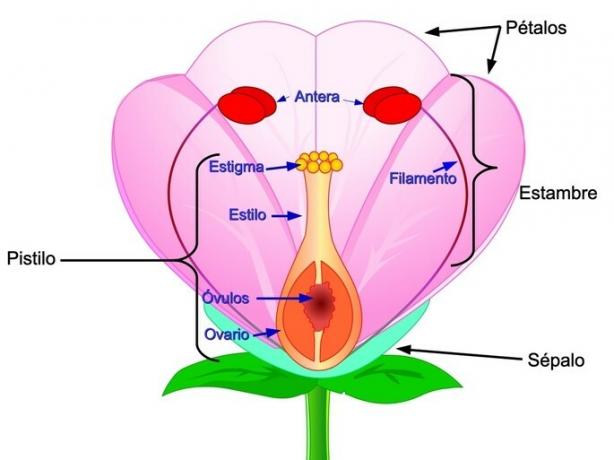
The diversity of flowers depends on the presence or absence of each part of the flower. For example, wind-pollinated flowers do not need petals, like the flowers of corn or wheat.
Fruit
The fruit is the dispersal unit of the seeds. It develops from the maturation of the flower, the fleshy part derives from the ovary and the seeds derive from the ovules.
After a sperm cell fertilizes an oocyte, the embryo and surrounding tissues grow into a seed, at the same time that some of the ovarian tissue develops into a fruit.
You may also be interested in seeing:
- angiosperm and gymnosperm
- Monocots and Dicots
- Fruit and vegetable
References
Crang R, Lyons-Sobaski S, Wise R. (2019). Plant anatomy- A concept-based Approach to the structure of seed plants. Springer Nature, Switzerland.
Mauseth, J.D. (2016). Botany-An introduction to plant biology, 6th ed. Jones & Bartlett Learning. Burlington, MA.

